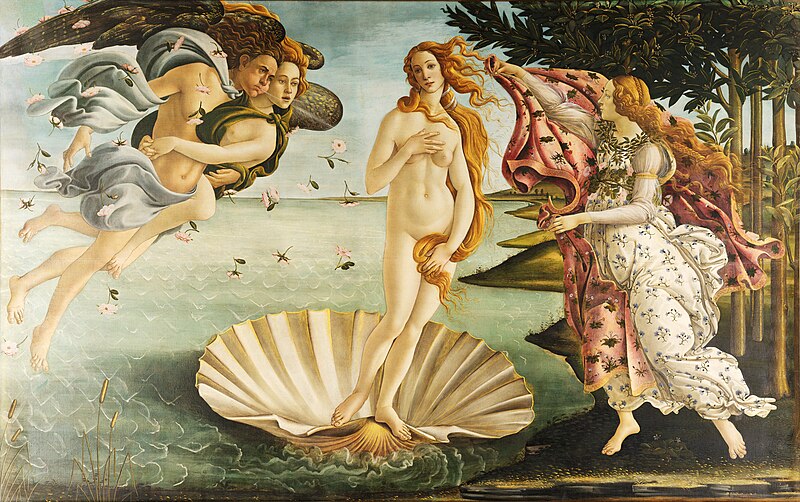Italian
Renaissance Artists and Their Paintings:
 |
| Animated Clippings of Famous Renaissance Paintings |
Leonardo
da Vinci (1452-1519):
 |
| Leonardo da Vinci |
Was an Italian Renaissance polymath: painter,
sculptor, architect, musician, mathematician, engineer, inventor, anatomist,
geologist, cartographer, botanist, and writer. His genius, perhaps more than
that of any other figure, epitomized the Renaissance humanist ideal. Leonardo
has often been described as the archetype of the Renaissance Man, a man of
"unquenchable curiosity" and "feverishly inventive imagination".
He is widely considered to be one of the greatest painters of all time and
perhaps the most diversely talented person ever to have lived. According to art
historian Helen Gardner, the scope and depth of his interests were without
precedent and "his mind and personality seem to us superhuman, the man
himself mysterious and remote". Marco Rosci states that while there is
much speculation about Leonardo, his vision of the world is essentially logical
rather than mysterious, and that the empirical methods he employed were unusual
for his time.
 |
| Mona_Lisa |
 |
| DaVinci_Last-Supper |
Michelangelo Buonarroti (1475-1564)
 |
| Portrait of Michelangelo |
commonly
known as Michelangelo was an Italian sculptor, painter, architect, poet, and
engineer of the High Renaissance who exerted an unparalleled influence on the
development of Western art. Despite making few forays beyond the arts, his
versatility in the disciplines he took up was of such a high order that he is
often considered a contender for the title of the archetypal Renaissance man,
along with his fellow Italian Leonardo da Vinci.
 |
| The-Torment-of-Saint-Anthony-by-Michelangelo. |
 |
| The-Conversion-of-Saul-by-Michelangelo |
Raphael
Sanzio (1483-1520):
 |
| Raphael |
better
known simply as Raphael, was an Italian painter and architect of the High
Renaissance. His work is admired for its clarity of form and ease of
composition and for its visual achievement of the Neoplatonic ideal of human
grandeur. Together with Michelangelo and Leonardo da Vinci, he forms the
traditional trinity of great masters of that period.
 |
| Raphael_-_Resurrection_of_Christ |
 |
| School-of-athens-by-raphael. |
Sandro
Botticelli (1445-1510):
 |
| Probable self-portrait of Botticelli, in his Adoration of the Magi. |
was an Italian
painter of the Early Renaissance. He belonged to the Florentine school under
the patronage of Lorenzo de' Medici, a movement that Giorgio Vasari would
characterize less than a hundred years later as a "golden age", a
thought, suitably enough, he expressed at the head of his Vita of Botticelli.
Botticelli's posthumous reputation suffered until the late 19th century; since
then his work has been seen to represent the linear grace of Early Renaissance
painting. Among his best known works are The Birth of Venus and Primavera.
 |
| Adoration-of-the-Magi-by-Sandro-Botticelli. |
 |
| Birth-of-Venus-by-Sandro_Botticelli |
Titian
(1488-1576):
 |
| Self-Portrait of Titian |
was an
Italian painter, the most important member of the 16th-century Venetian school.
He was born in Pieve di Cadore, near Belluno (in Veneto), in the Republic of
Venice. During his lifetime he was often called da Cadore, taken from the place
of his birth.Recognized by his contemporaries as "The Sun Amidst Small
Stars" (recalling the famous final line of Dante's Paradiso), Titian was
one of the most versatile of Italian painters, equally adept with portraits,
landscape backgrounds, and mythological and religious subjects. His painting
methods, particularly in the application and use of color, would exercise a
profound influence not only on painters of the Italian Renaissance, but on
future generations of Western art
 |
| Emperor-Charles-by-Titian |
 |
| The-Worship-of-Venus-by-Titian |
Albrecht
Durer (1471-1528):
 |
| Durer_selfporitrait |
was a
German painter, engraver, printmaker, mathematician, and theorist from
Nuremberg. His high-quality woodcuts (nowadays often called Meisterstiche or
"master prints") established his reputation and influence across
Europe when he was still in his twenties, and he has been conventionally
regarded as the greatest artist of the Northern Renaissance ever since. His
vast body of work includes altarpieces, religious works, numerous portraits and
self-portraits, and copper engravings. The woodcuts, such as the Apocalypse
series (1498), retain a more Gothic flavour than the rest of his work. His
well-known prints include the Knight, Death, and the Devil (1513), Saint Jerome
in his Study (1514) and Melencolia I (1514), which has been the subject of
extensive analysis and interpretation. His watercolours also mark him as one of
the first European landscape artists, while his ambitious woodcuts
revolutionized the potential of that medium.
 |
| Albrecht_Durer-St_Jerome_in_the_Wilderness-1495 |
 |
| Albrecht_Dürer_adam_and_eve. |
















































